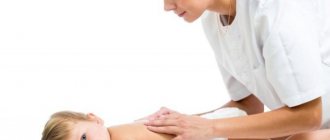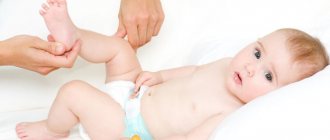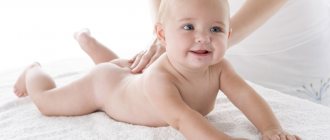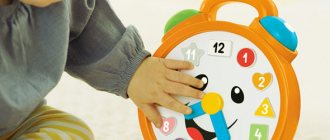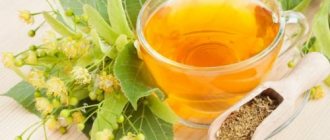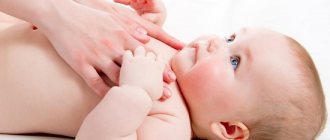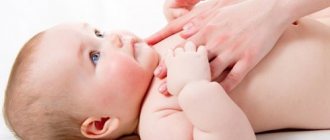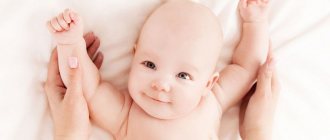We are used to treating our own colds with the magical “it will go away on its own” method. We continue to go to work, swallow packs of cough lozenges and drink tea with lemon. If a child is sick, jokes are put aside and treatment takes a serious turn. Children in the first years of life have a hard time suffering from respiratory infections. Even in the absence of fever, painful cough and difficulty breathing disrupt the sleep and appetite of babies. Percussion massage will help quickly cope with a child’s illness, a technique that every mother should master.
In young children, coughing occurs reflexively. More often it is superficial, not effective, and the child cannot yet specifically strengthen it. The mucous membranes of the bronchi are covered with viscous mucus, which makes breathing difficult and causes coughing.
The essence of percussion massage is rhythmic tapping of the chest. The vibration created by this leads to the separation of sputum from the walls of the bronchi.
In addition to mechanical separation of phlegm and easier breathing, percussion chest massage has other significant benefits:
- Distraction and general relaxation. Rhythmic tapping and stroking of the chest, coupled with a friendly tone and smile, will calm the child. Breathing will become deeper.
- Blood flow to internal organs. The heart is better supplied with oxygen and nutrients and works more efficiently.
- Blood supply to the pectoral, intercostal muscles and diaphragm. These muscles take part in the act of breathing. Therefore, increased muscle blood circulation leads to an increase in tidal volume. Ultimately, the child becomes more resilient and tolerates physical activity better.
Purpose of massage treatments
Percussion massage sessions are aimed at removing mucus from the respiratory tract. From Latin, “percussion” is translated as “tapping”, used to study the state of internal organs and determine their position by sound. Sessions are prescribed based on the type of cough:
- For a dry cough, procedures are carried out to increase its humidity and more quickly remove phlegm. During an attack, tension in the muscle tissue of the chest and diaphragm leads to severe pain;
- For a productive or wet cough, the purpose of the massage is to cleanse the bronchi of mucus and pathogenic bacteria.
Percussion massage is not an independent method of treating cough, but is necessarily part of complex therapy. It is also prescribed during the recovery period after complex colds. The effectiveness of massage is based on the activation of lung receptors: information about irritation is transmitted via nerve endings to the respiratory center of the brain, and returns back in the form of reflex stimulation of respiratory abilities.
Benefit
Massage for coughs in adults and children brings a positive effect if the technique is followed. The procedure is aimed at:
- Stimulation of the basic functions of the respiratory organs;
- Improving the movement of biological fluids in the bronchi and lungs;
- Dilatation of blood vessels;
- Increase in the volume of the pulmonary chambers;
- Relief of spasms;
- Acceleration of sputum removal;
- Increased muscle tone;
- Reduced pain symptoms;
- Restoring the elasticity of muscle fibers;
- Relaxation.
People of all ages can massage when coughing: the difference in technique lies only in the strength of the impact and the depth of treatment.
Percussion procedures are a series of light vibrations, the role of which is to separate particles of sputum from the inner surface of the bronchi. Sessions help activate the intercostal muscles, normalize the functioning of the respiratory system and reduce inflammatory processes. After the massage, patients feel rested, notice a decrease in pain and the appearance of easy, free breathing.
Cupping massage
Cupping massage for cough treatment is carried out using medical cups, which can be purchased at the pharmacy. This type of massage is indicated for tracheitis, bronchitis, pneumonia, pleurisy after the acute phase of the disease has subsided. Cupping massage helps remove mucus from the respiratory tract and get rid of a lingering cough. It should only be carried out by a specialist.
Cupping massage should be carried out very carefully so as not to burn the child
To perform cupping massage, the back should be lubricated with Vaseline or oil to improve the sliding of medical cups. The jars are lubricated with alcohol from the inside, brought to the skin, set on fire inside, making sure that the edges of the jars do not heat up, and with a sharp movement they are placed on the back. Do not allow alcohol from the jar to drip onto your skin. Two cans are installed at the level of the 2nd thoracic vertebra, after which the cans are moved down and up along the spine 6-8 times on each side. After this, a spiral movement is performed along the spine, also 6-8 times. Finally, the intercostal lines are massaged, 2 times up and down along each line. After this, light stroking is carried out in the area where the procedure is performed; after the massage, the child should be covered with a blanket for 20-30 minutes.
Cupping massage is not performed on young children.
Massage is not done immediately after eating or if the child experiences discomfort in the tummy position.
Contraindications
Percussion massage technique refers to active physiotherapy procedures, therefore it has limitations for its implementation.
Contraindications include:
- Bronchitis in the acute stage and bronchial asthma;
- 3rd degree of hypertension, disturbances in the functioning of the cardiovascular system;
- Oncological lesions of the respiratory system;
- Inflammation of the lungs and nasopharynx;
- Temperature and its residual symptoms;
- Active form of tuberculosis;
- AIDS, skin and venereal diseases;
- Increased risk of thrombosis;
- Mental disorders.
Temporary contraindications include alcohol intoxication and vomiting. Self-massage must be agreed upon with your doctor.
Colds and acute respiratory infections
When suffering from a cold, patients are accustomed to drinking liters of hot tea, eating it with cough marshmallows and putting drops in their nose every three to four hours. But as soon as a viral disease affects children, parents immediately turn to specialists, fearing that a common cold could develop into something more serious.
Many children cannot boast of strong immunity, and therefore, in the off-season, acute respiratory diseases affect them more often than other people. But it is impossible to keep a child on antibiotics for a long time; over time, they stop working, and then the doctors give up. To avoid this outcome, every mother should master chest massage for bronchitis.
Percussion massage technique
The percussion method is a healing technique aimed at stimulating the upper respiratory tract and maintaining communication between the center of the respiratory system and the ventilation apparatus. The session can be accompanied by meditative music to relax the client, and essential oils and aromatherapy can also be used during the treatment. When choosing a scent, it is better to give preference to esters that have a beneficial effect on the respiratory system:
- Cinnamon;
- Thyme;
- Rosemary;
- Cedar;
- Peppermint;
- Lavender;
- Juniper;
- Eucalyptus;
- Fir;
- Tea tree.
Eucalyptus oil for cough massage
You can use either one essential composition or a mixture of several oils based on a basic massage cream.
The positive effect is explained by tapping the back, chest and ribs with your fingers. During exposure, vibrations activate the movement of biological fluids, relieve fatigue and improve breathing and pulmonary ventilation. The technique helps you take a deeper breath, which has a good effect on oxygen saturation of tissues.
Methodology of the session
Massage sessions are both therapeutic and preventive in nature. The percussion massage procedure has the following technique:
- The massage therapist presses one palm tightly against the patient’s body, the other makes striking movements with his fist on top;
- After several low-force blows on one area, the palm is moved and the technique is repeated.
Cough massage is carried out on both sides of the chest, and on the back only the area of the shoulder blades is treated separately. No more than three symmetrical strikes are recommended for each area. Work always begins from the front of the chest, the area under the collarbones and under the costal arch. Then they move on to the shoulder blades, not forgetting to go through the surface between them.
During inhalation, the massage therapist’s hands should slide along the intercostal muscles, and when exhaling, towards the sternum. After tapping with fingers or fists, the chest is compressed: hands are placed on the lower side near the diaphragm and squeezed with force. Then massage the area near the armpits. And to make breathing easier, the patient is given instructions on the time and duration of inhalation and exhalation.
Compression of the chest leads to irritation of the alveolar receptors, which leads to a response in the form of activation of the respiratory function of the lung. The session lasts 5-10 minutes and can be performed up to twice a day. After treatment, there is an improvement and release of breathing, a decrease in spasms and pain, and active discharge of sputum.
Tapping technique
Percussion massage is carried out on a hard surface at an air temperature of 22-25°C. It is better to do tapping before meals, but after a day or night sleep, when a large amount of sputum has accumulated in the bronchi. Calm your child down in advance and make sure his body temperature is not elevated.
Place the baby on his stomach and, if possible, extend his arms forward. Place a pillow under the abdomen and pelvis area so that the body is at an angle. This position will facilitate the release of viscous sputum. To prepare your baby for percussion massage, rub your baby's back for two minutes. After this, slightly bend the fingers of your hand and tap the tips intensively and often on the back, avoiding the kidney area. Position your fingers so that they point towards your head. Perform tapping for about a minute, then place the child in an upright position or sit down and allow him to cough. Lay your baby down again and continue tapping. One session consists of 4-5 such cycles. At the end of the procedure, rub the skin again.
Percussion massage can be performed on the back and sides of the chest. Breast tapping is also acceptable, but not required. During the procedure, monitor the child’s breathing and ask him not to hold his breath.
The percussion massage technique is simple to perform and does not require special knowledge or skills of a massage therapist. Every parent can master tapping. The procedure will not take much time, but will increase the effectiveness of cough treatment. Use percussion massage sessions to become even closer to your baby.
Additional cough techniques
In addition to percussion, there are several more specialized techniques used for bronchitis, pleurisy, etc. They can be prescribed as additional therapy for illness in combination with other massage techniques or carried out after recovery to improve respiratory functions.
Drainage
Massage procedures normalize breathing and help remove edematous fluid from the cavities and tissues of the body, which accumulates as a result of inflammatory processes. After tapping, there is an improvement in respiratory functions, an increase in the tone of the pectoral muscles and an increase in the displacement of the vertebrae of the thoracic spine during the breathing cycle.
Drainage technique for coughing
Massage is indicated for bronchitis, as well as for:
- Bronchial asthma;
- Pleurisy;
- Emphysema;
- Pneumonia.
You can start the session when the humidity level in the room is above 65%. A lower value will make it difficult for sputum to come out. The second condition for carrying out is the absence of inflammation in the respiratory organs and the patient’s body temperature is within normal limits. Failure to comply with these conditions can cause muscle spasms and phlegm retention in the bronchi.
How to massage babies
Percussion massage is recommended for infants. This technique is quite simple to perform and does not take much time. To carry out the procedure, the baby must be positioned on a horizontal plane or on an adult’s lap so that the pelvis is higher than the head. After this, a massage is performed using light vibration movements using the fingertips or the edge of the palm. The tapping takes place in the lung area. It is important not to perform massage actions at the kidney level - this can lead to pathological disorders.
Video of baby (percussion, drainage) massage (from three months). After performing the vibrations, the baby must be put on his feet and the mucus removed from the oral cavity. If the mucus is located in the throat, the child must be helped to get rid of it by inducing a gag reflex. To do this, you need to lightly press the tip of the tongue with a teaspoon - this will help the baby cough up the mucus. Such actions must be repeated 3-4 times per session. The entire procedure is performed within 10 minutes.
Massage for coughs in children: how to do drainage and percussion massage for sputum removal in the video
To understand when a child needs a massage when coughing, it is important to understand the manifestations of the disease:
- In the initial phase, while the inflammatory process is developing, the mucous membrane covering the bronchi is irritated and dry. A dry cough occurs, which is called non-productive. At this time, it is too early to do massage practices; there will be no benefit from them.
- On days 3-5, the cough becomes wet and productive: liquid discharge appears in the form of sputum. It's time to start a course of procedures.
- After the completion of the active phase of the disease and the cessation of coughing, it is recommended to continue the course of procedures for several more days.
Pediatricians recommend starting a course of cough treatments, in the absence of contraindications, as soon as the acute phase of the disease ends and the body temperature returns to normal (our review about suppositories for fever for children). Here are the main indications:
- complications after acute respiratory infections, flu;
- bronchitis, including COPD;
- some cases of pneumonia;
- pneumosclerosis;
- cystic fibrosis;
- remission during bronchial asthma.
The correct cough massage technique for children can significantly alleviate the condition during illness.
What happens as a result of well-performed manipulations:
- Bronchial mucus thins out and becomes more transportable.
- The movement and evacuation of sputum from the bronchi accelerates.
- Along with mucus, pathogenic microflora is removed from the body: bacteria, viruses, microorganisms.
- The mobility of the ribs increases, breathing and blood circulation in the chest are normalized.
- The effect of medications increases.
How does massage help remove mucus? With poor development of the respiratory muscles, coughing up sputum in children is difficult. Constant coughing irritates the throat, and coughing up phlegm becomes very painful.
As a result of massage manipulations, special cilia on the surface of the bronchial mucosa, designed to push mucus out, increase their activity. Stimulating blood circulation increases the production of bronchial secretions, which further thins the mucus.
Basic techniques
Classic techniques are designed for individual use or combination depending on the indication. General conditions to be observed:
- At least two hours should pass after eating.
- 30 minutes before the session, the child needs to take medications to thin the sputum.
- There should be no drafts in the room during the procedure; the air temperature should preferably be within 22-24 °C.
- After the session you cannot eat for about 1 hour.
Types of massage
| Child's age | Types and features of manipulations | Duration of procedures |
| Up to 3 months | Babies at this age are not prescribed massage | — |
| 3 months-1 year | Only a professional massage therapist can perform therapeutic procedures. The session consists of light stroking, rubbing and finger tapping. Be sure to use neutral oil for your baby's skin. | Up to 5 minutes, 1 time per day |
| 1-3 years | You can perform light vibration massage with caution, as well as honey massage - in the absence of an allergic reaction | 5 to 10 minutes, up to 2 times a day |
| 3-7 years | It is allowed to use percussion, drainage and honey techniques (without oil), and cupping techniques - with the use of neutral oils | 15-20 minutes, up to 3 times a day |
| Over 7 years old | All types of massage manipulations are allowed | 25 minutes, up to 4 times a day |
Drainage
When performing drainage massage for children when coughing, make sure that the middle part of the patient’s torso is higher than the head . The patient lies face down with a pillow placed under the stomach. Main stages of action:
- Warming up the chest. It is performed by stroking and rubbing movements.
- Warm up the intercostal muscles. Light longitudinal movements are used to treat the back and sides from bottom to top. The spine area is not affected.
- Using pinching movements, the entire surface of the back is worked in the direction from the lower back to the head.
- The edge of the palm is used to tap the entire back from bottom to top.
- Using both hands, lightly compress the body from the sides in the diaphragm area.
The video below additionally explains in what cases drainage massage is prescribed and the correct technique for performing it:
Vibrating (percussive)
An example of performing vibration chest massage for children is presented in the video. This simple method consists of repeatedly tapping the back with the edge of the palm in the direction from the middle of the back to the neck.
The implementation option that Dr. Komarovsky shows is tapping the fingers of a weakly clenched fist. The spine area is not treated. After the session, you need to invite the patient to cough well, moving him to an upright position.
Honey
Having found out whether the child is allergic to bee products, you can conduct a session of therapeutic manipulations with honey. This qualitatively warms up the chest and increases blood circulation. Sequencing:
- Body position – lying on your stomach.
- The back is warmed up with light rubbing and stroking movements.
- Apply a sufficient amount of liquid honey and distribute it evenly.
- The stroking movements end with a sharp lifting of the hands from the skin, while the sticky honey creates difficulty.
- The procedure is completed by wiping off the remaining honey and wrapping it warmly.
This popular method, developed in China, requires special knowledge and skills. Acupressure for coughs in children can only be effectively performed by a qualified specialist .
The technique uses biologically active points located on the energy meridians of the body organs.
Not only the correct choice of location is important, but also the strength and duration of the impact on the meridians.
Canning
This method increases subcutaneous blood circulation in the chest and strengthens the overall immunity of the body. Medical jars made of glass or rubber are used for it. Stages of the treatment session:
- Abundantly lubricate the skin with oil or cream.
- Installation of cans.
- Sliding movements with cups, capturing part of the skin inside the jar.
- The entire surface of the back is worked, excluding the areas of the spine and armpits.
- The session ends with a warm wrap.
How to prepare for the cupping massage procedure and the technique for performing it, watch the video:
Contraindications: in what cases the procedure cannot be performed
There are a number of restrictions for performing procedures in children. In addition to the acute phase of a respiratory or infectious disease, which is always a contraindication, there are the following risk factors:
- Heart diseases, including congenital defects.
- Diseases of the kidneys and liver in the acute phase.
- Allergic manifestations on the skin (see more about the types of rashes in a child).
- Asthma during an attack.
- Oncological diseases.
- Nervous system disorders.
- Body weight deficiency.
- Hernias.
About the TOP 12 antiviral drugs for children from 1 year old are written in this publication, and about the treatment of barking cough in this article.
From parents' reviews
Yulia, 33 years old, Podolsk, son 5 years old
During my son’s treatment for bronchoneumonia, I learned from my local doctor about the opportunity to undergo a course of special drainage massage at the clinic. After 10 sessions, the son began to sleep better, and the night coughing attacks gradually disappeared.
Of course, this was done at the very end of treatment, after a course of antibiotics and inhalations. But my baby liked the procedure, and now we often do it at home. The son himself comes up and asks to massage him!
Source: //ipupsik.com/uhod-za-rebenkom/massazh-pri-kashle-u-detej.html
Indications
Percussion massage is ideal for those who not only often suffer from colds, but also those who have chronic respiratory diseases. Percussion massage also relieves fatigue, stress and relaxes the body.
The procedure is most often performed using aromatherapy and relaxing music, which only has a positive effect on a person.
Percussion massage can completely get rid of bronchitis, pneumonia, dry cough and other respiratory tract diseases. However, it is important to remember that this is just an additional procedure during therapy, and only a specialized doctor can prescribe it.
Drainage massage for children with a cough to remove sputum: how to do it at home
Drainage massage for children when coughing helps get rid of excess phlegm due to a specific body position during the procedure.
This massage is called percussion because of the technique used, because in Latin “percussion” means “tapping”. It can be performed not only by a doctor in a treatment room, but also by parents or other relatives at home.
The main thing is to adhere to safety precautions and properly prepare the baby, especially the infant.
Operating principle of drainage massage
During massage movements when coughing, blood supply and lymph flow in the chest area increases. This increases its mobility and also accelerates blood flow. The impact causes mucus in the lungs and bronchi to form faster and to be coughed up more easily.
Massaging a child with a cough is called drainage when the torso is slightly tilted down. In this case, mucus is coughed up better thanks to natural drainage, the role of which is played by the trachea and larynx.
When is the procedure useful?
A cough massage is given to a child in order to strengthen the existing cough reflex. If the child is a newborn, infant or preschool age, his own respiratory system is imperfect.
Because of this, the baby cannot fully cough to remove sputum. To strengthen the existing cough reflex, develop the muscles of the chest and warm up the bronchial tree, massage is used.
The technique is allowed if a wet cough is caused by:
- ARVI or acute respiratory infections with associated tracheitis;
- pneumonia;
- bronchitis of a viral, bacterial or fungal nature;
- emphysema;
- tuberculosis and cystic fibrosis.
Contraindications for implementation
Massage is contraindicated:
- Immediately after eating. Neglecting this rule causes vomiting in some children.
- For cardiovascular diseases, renal pathologies. The acceleration of blood flow when coughing provokes increased stress on the cardiovascular, respiratory and excretory systems. When they become ill, the child’s condition worsens.
- In the acute stage of the disease, which provokes a severe cough. This stage is accompanied not only by a cough, but also by a rise in body temperature. The massage effect in this case will increase the load on the respiratory and cardiovascular systems, and will also provoke an additional increase in temperature.
- The child has skin diseases. To relieve coughing, the skin is rubbed and pinched, which increases injury to the epidermis and also increases the risk of infection of the rash or ulcers.
Also, before choosing massage as a treatment method, it is worth determining the type of cough. Massaging a dry cough will only make it worse. For dry, medications and techniques are indicated that suppress the reflex, rather than enhance it.
How to do drainage massage for coughs
For a massage procedure, it is not necessary to involve a specialist - one of the parents can perform it. The main thing is to prepare properly, namely cut your nails, wash your hands, remove rings and bracelets.
Preparing the child
Before giving a massage to a child at home, it is necessary to measure his body temperature and wash off dirt and sweat from the skin. The child, wiped dry, is carried or taken into a well-ventilated room.
The room must be maintained at a comfortable temperature - a child with a cough should not be cold without clothes. Before performing the massage, the child is placed on a table or couch with a small cushion placed under the stomach.
Execution technique
The procedure consists of two stages:
- Back massage. First, do 20 strokes from the lower back to the neck. This prepares the skin for the further procedure, and also sets the direction for the outflow of mucus during coughing. In the future, all movements are performed in this direction. After stroking, they begin pinching and tapping. When performing movements, it is important to avoid the kidney area (lower ribs), and also not to pinch the skin above the spine.
- Chest massage. The child is turned over, placing a cushion under the lower back. The chest is first stroked towards the collarbones, and then massaged in a circular motion clockwise and counterclockwise.
Completing the procedure
The warmed skin of the child will turn red from the massage. You can't let him run around the house in this state. The baby needs to be wrapped in a blanket and forced to sit/lie in bed for an hour and a half.
The child’s cough will intensify, so it is not advisable to give the baby food or water within 2 hours after the procedure. Neglecting this measure will cause vomiting, which will irritate your sore throat.
How to properly massage a baby
Drainage massage is allowed for infants from 3 months, but such children have very delicate skin, so you need to be careful with them. Before the massage, be sure to not only wash your hands, but also warm them and lubricate them with baby cream. You cannot use massage oils from “adult” series - they contain fragrances and components harmful to small children.
Babies do not control the process of urination and defecation, so before the procedure the table is covered with oilcloth and a diaper.
After the massage, be sure to wrap the baby in a blanket and put him to bed. Every 15 minutes the child is turned over to the other side so that mucus does not stagnate in the bronchi.
You should not place the child on his back, since even a light massage risks provoking increased gag reflexes.
Children under one year old are unable to talk about their discomfort, so you will have to monitor the child’s reaction to the procedure.
If the baby cries during a drainage massage, you must stop. If the condition worsens after the massage, parents should contact their pediatrician.
Other types of massage for coughs in children
In addition to the drainage method of treatment, you can use honey, vibration and acupressure. Each method has its own characteristics and contraindications. The first two methods are available at home; the procedure does not require anyone's help.
Spot
Chinese technique. It is based on the doctrine of points on the human body associated with organs and systems. In China they still believe that influencing certain points normalizes the functioning of the body.
This method will only work if the work is performed by a specialist who understands physiology, manual therapy, and the Chinese method.
In children, the procedure does not cause discomfort that may occur during chest drainage massage.
Vibrating
The technique used to perform a vibration massage for cough differs from a drainage massage. The back in the chest area is not massaged, but tapped. The vibrations from these taps improve the discharge of sputum. You cannot knock on your bare back - you must place one hand on top of the body and lightly hit it with the other.
This way, vibration is transmitted to the baby’s body, but the risk of accidental injury is eliminated. The spine area should not be tapped even through the hand.
Features of massage for infants
When coughing, children under 1 year of age may also produce sputum, but they will not have enough strength to cough it up. Parents can help their child with drainage massage to remove mucus.
Before the session begins, you need to feed and let the baby burp. That is, you need to massage 30-40 minutes after eating. Manipulations are performed only with the fingertips and only on the back, but otherwise the technique is no different from massage for older children.
For infants, a session of 5 minutes will be sufficient.
The video shows a complete diagram of drainage massage for children: https://www.youtube.com/watch?v=g369Osx54ro
